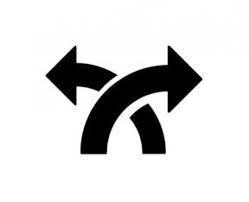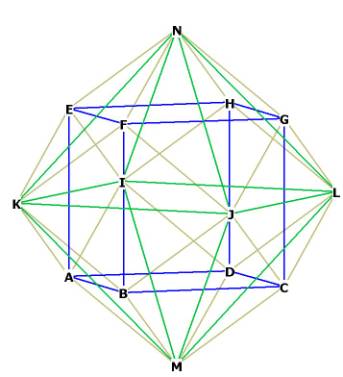|
(2019
midterm assignment) Model Midterm answers 2019 (Index) Essay 1: Compare, contrast, and evaluate Narratives of the Future |
 |
Brandon Burrow
Apocalypse Now or Later: 3 Narratives of the Future and How they Interconnect
Throughout this course we
have studied literature written across time by authors who were trying to make
sense of the future to the best of their abilities by utilizing the technologies
and symbols that were present in their own cultures to imagine it. Much of this
work adheres to one of three common future narrative paradigms: the
Creation/Apocalypse model, the Evolution model, or the Alternative model. These
three ways of exploring future narratives differ in their time and scale,
structure, and literary appeal, but interconnect in ways that make them all
interesting lenses to study the “literature of ideas” through (discussion).
The Creation/Apocalypse
model is perhaps the most prevalent and primal narrative style in existence.
Genesis begins as far back as possible, with the creation of everything from a
formless “void” (course site). As Clark Omo notes in his 2017 essay “The Future
Duo: The Links Between the Two Narratives,” these stories consist of a “definite
beginning and a foreseeable ending” (Omo 2017). The Genesis/Revelation timeline
also conforms to the linear Aristolean concept of storytelling as it features a
concrete “beginning,” “middle,” and “end” (course site). The biblical narrative
starts with the Creation and bliss of Eden, proceeds to exile, trials, and
tribulations for mankind, climaxes with the events detailed in Revelation, and
ends with Heaven aka New Jerusalem descending as an eternal utopia for the
faithful. Jesus, symbolized by the bloody lamb, emphasizes repeatedly in
Revelation that he is “Alpha and Omega, the beginning and the end,” adhering to
the neat linear chronology often present in Creation/Apocalypse narratives
(course site).
In Octavia Butler’s
Parable of The Sower, we see a
narrative that begins reminiscent of the Creation/Apocalypse model that morphs
into the Evolution model as the novel progresses, mirroring the change in Lauren
as her faith evolves in the post-apocalypse. Laura Wilson notices that in
Parable Lauren begins in a state
redolent of Genesis: “like Adam and Eve in the garden of Eden, the community
Lauren lives in is something of a utopia, at least amid the horrors of the city”
(Wilson 2017). Lauren likewise loses this community of innocence in a fashion
similar to how Adam and Eve lose theirs. Lauren’s community’s inability to
follow the directives that God (Change) is mandating them (to prepare adequately
for the inevitable attack), causes their downfall just as the insubordination of
Adam and Eve does theirs. After this inciting incident, the future is uncertain,
and the reader can see how different outcomes are possible as Lauren is forced
to adapt if she wants to survive.
In evolutionary narratives
time is often seen as a spiral, and this is evident in Lauren’s worldview in
Parable.
In a world that has largely fallen into a downwards spiral of decline,
she chooses to adapt and change her own behaviors and mindset as she guides
herself and her Earthseed followers along an upwards spiral of progress that
rebels against the status quo of death and destruction present in
Parable. After losing her Eden,
Lauren realizes that she can’t wait for the Christian God of her childhood to
“fix things for [her] or [to] take revenge for [her],” and instead wholly adopts
the view that God is “not punishing or jealous, but infinitely malleable” (220).
In other words, Lauren’s path is not pre-ordained as she can evolve and change
her story, shaping the world around her through her actions.
Another story that blurs the
lines between decline and progress is H.G. Wells’s
The Time Machine. When the Time
Traveler first arrives in the future, he sees it as a “golden age” (5.18).
However, the Time Traveler rethinks his original assessment of the future after
his adventure in the Morlock’s tunnels as Timothy Morrow notes in his 2016 essay
“A Phoenix Must First Burn: Analyzing Decline in Future Narratives;” while at
first the “future of the Time Machine
seems like the perfect paradise,” in reality it is a “world in decline, where
the human races [the Eloi] began to weaken [due to] the environment they evolved
in” (para. 5). Once the Time Traveler realizes that the Eloi are merely the
“fatted cattle” of what used to be the industrial lower-class Morlocks, he finds
himself grieving for the “human intellect” of the Eloi that had “committed
suicide” when they allowed themselves to become stagnant and comfortable (7.15,
10.2-3). Using the language of Darwin, the Time Traveler reminds the reader that
“there is no intelligence where there is no change and no need of change. Only
those animals partake of intelligence that have to meet a huge variety of needs
and dangers” (10.3). In other words, environmental stimulants, like the
necessity of staying productive and self-sufficient in
Time Machine or the antagonism of the
world going to hell around Lauren in
Parable, inspire “survival of the fittest” adaptive measures and are the
essential catalysts for change (coursesite). In the evolution narrative, you are
either growing or you are fading.
There exists a third future
narrative, known as alternative, which delves into interpretations of times as
best understood by physics and advanced technology. As Greg Bellomy wrote in
2017, “the alternative future vision, which is not constrained by the revelation
of divine wisdom [as in creation/apocalypse models] or eons of unimaginable time
[time spans associated with evolutionary progress], gives authors the freedom to
explore ideas in ways that does not quite make temporal or spatial sense (much
like quantum theory)” (para. 5). In “Mozart in Mirrorshades” by Bruce Sterling
and Lewis Shiner, this model is seen when an alternate branch of the past is
exploited and mined for its resources by agents of the one true timeline,
“realtime.” The protagonist Rice explains that “history is like a tree…when you
go back and mess with the past, another branch of history splits off from the
main trunk” and has no impact on the “realtime” future that Rice himself is from
(227). Tree-like branching paths of time is a common way to understand the
multiple possible timelines created by the interaction between different
realities. “Mozart” uses this metaphor of dead branches falling off the tree of
time to narratively illustrate the harmful and chaotic effects of appropriating
and exploiting less developed or technologically advanced cultures in the name
of capitalism.
Another way that the
alternative time narrative is modeled is through the symbolism of labyrinths as
seen in Jorge Luis Borges’s “The Garden of Forking Paths.” The narrator of the
story searches for a book penned by his ancestor that doubles as a labyrinthine
puzzle containing all possible presents, pasts, and futures based on the varying
actions of individuals. His desperation to solve the “abysmal problem of time”
and break through the static of alternate timelines to deliver his vital message
involves much philosophical inquiry into the nature of time and how uncertain it
can be (6). Greg Bellomy suggests in his 2017 narrative essay that, “in this
sense, the emergence of the alternative narrative seems to mirror the changing
ways in which we perceive the world” (para. 5). This idea can also be seen in a
version of the alternative narrative present in
Parable due to the inclusion of
climate change. Lauren knows that she is living in a timeline where people chose
to “deny reality” and contributed to the extreme weather patterns that now
plague their lives, but the masses do not choose to see reality as she does
(58). Alternative narratives often paint time and reality itself as malleable
and complex as opposed to the linearity of Creation/Apocalypse and the
rising/declining gradient of Evolutionary narratives.
The time, scale and
structure of these differing narratives are all depicted differently, and the
importance of them is likewise perceived differently by the reader, but, as
Katie Morin has observed, future narratives “are not entirely exclusive of one
another, and it is not uncommon to notice elements from one storyline present in
another” (2017). In the majority of the stories we have encountered this
semester a case can be made that a mixture of the three narratives weave
themselves throughout the structures of most stories in varying degrees.
Conceptions of the future are repeatedly used as a device to explore ideas of
decline and progress, as well as apocalypse, evolution, and emerging
understanding of the universe’s temporal and physical dimensions. While the
course that future development will take is often unclear, and the different
models showcase different methods of progress, possible realities, ends, and
speculations about where humanity is heading, one thing is certain—the future is
coming.
 |
 |
 |
